MITS5003 - Wireless Networks: Encoding, Error Control & Wi-Fi Security
VerifiedAdded on 2023/06/10
|18
|1739
|486
Homework Assignment
AI Summary
This document presents a student's solutions to a wireless networks assignment, focusing on encoding techniques, multiplexing, error control, and Wi-Fi network design. Part I covers encoding and error control, including calculating data rates, explaining encoding techniques like NRZ, Pseudoternary, and NRZ-Invert, and calculating CRC for a given status string. Part II discusses multiplexing techniques such as TDM, FDM, and CDMA, and compares OFDM with these techniques, highlighting its advantages in 4G and WiMAX. It also includes calculations for subcarrier bandwidth and bit time in an OFDM scheme. Part III focuses on Wi-Fi network design, including access point placement, BSS and ESS size calculations, throughput calculation for the distribution system, and recommendations for IEEE standards and security strategies. The document also includes references to support the explanations.
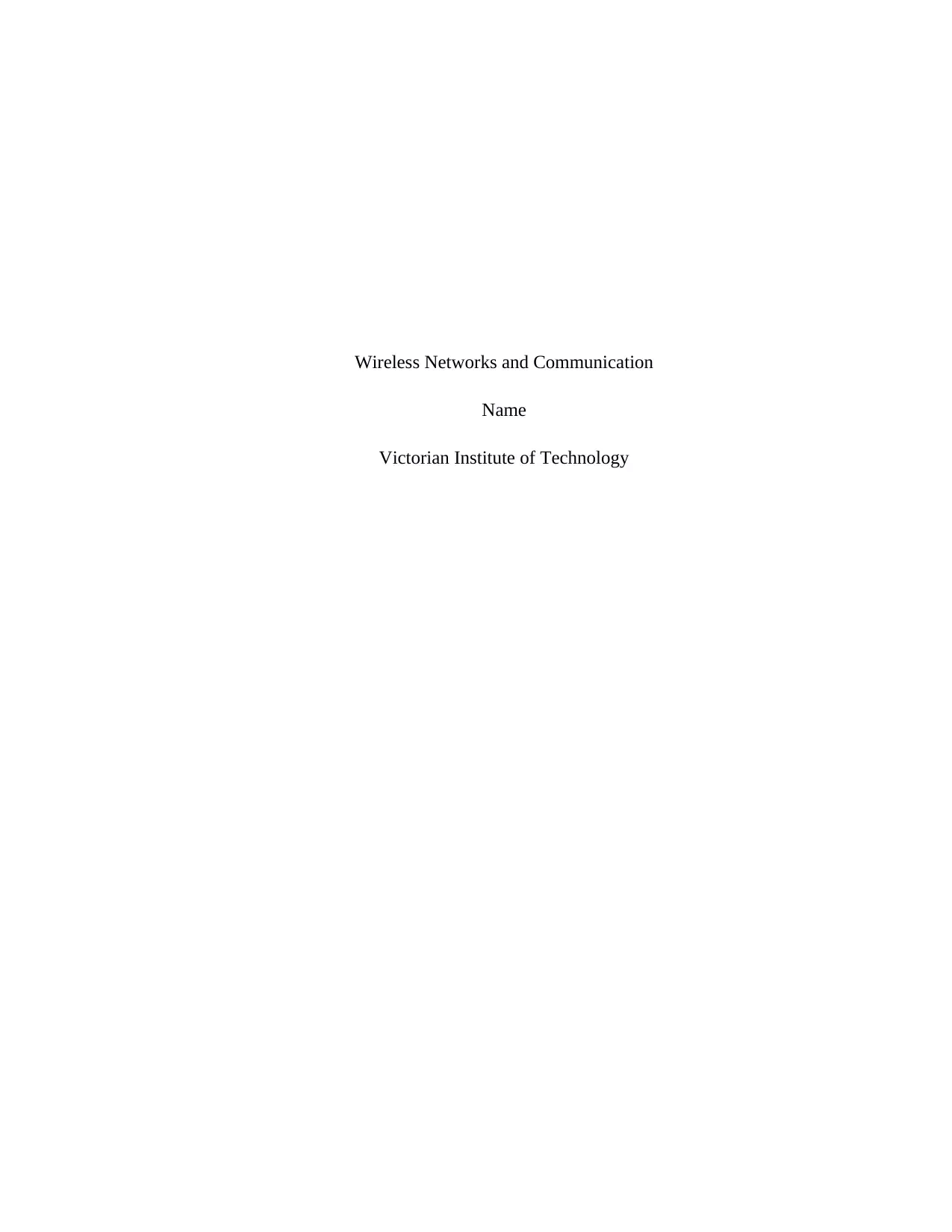
Wireless Networks and Communication
Name
Victorian Institute of Technology
Name
Victorian Institute of Technology
Paraphrase This Document
Need a fresh take? Get an instant paraphrase of this document with our AI Paraphraser
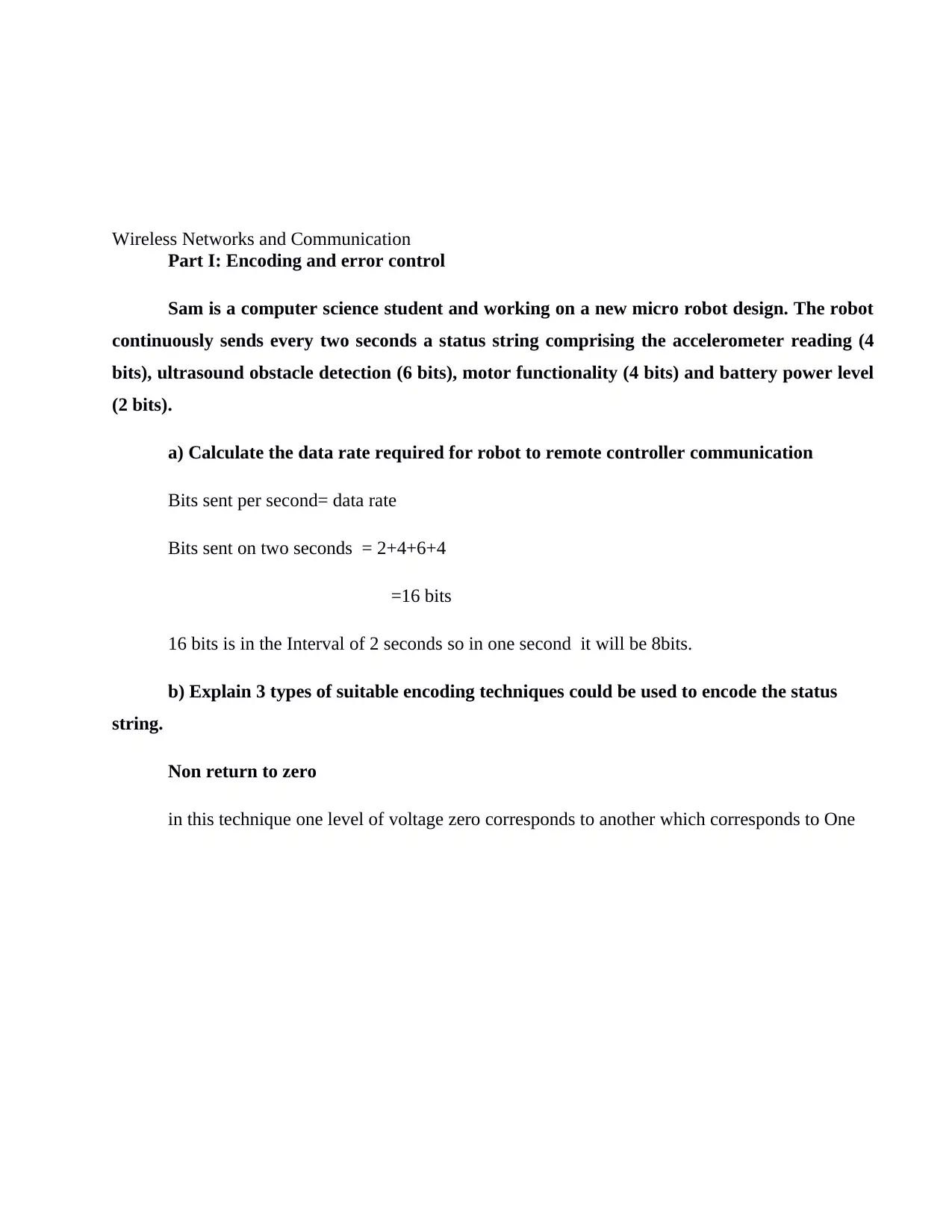
Wireless Networks and Communication
Part I: Encoding and error control
Sam is a computer science student and working on a new micro robot design. The robot
continuously sends every two seconds a status string comprising the accelerometer reading (4
bits), ultrasound obstacle detection (6 bits), motor functionality (4 bits) and battery power level
(2 bits).
a) Calculate the data rate required for robot to remote controller communication
Bits sent per second= data rate
Bits sent on two seconds = 2+4+6+4
=16 bits
16 bits is in the Interval of 2 seconds so in one second it will be 8bits.
b) Explain 3 types of suitable encoding techniques could be used to encode the status
string.
Non return to zero
in this technique one level of voltage zero corresponds to another which corresponds to One
Part I: Encoding and error control
Sam is a computer science student and working on a new micro robot design. The robot
continuously sends every two seconds a status string comprising the accelerometer reading (4
bits), ultrasound obstacle detection (6 bits), motor functionality (4 bits) and battery power level
(2 bits).
a) Calculate the data rate required for robot to remote controller communication
Bits sent per second= data rate
Bits sent on two seconds = 2+4+6+4
=16 bits
16 bits is in the Interval of 2 seconds so in one second it will be 8bits.
b) Explain 3 types of suitable encoding techniques could be used to encode the status
string.
Non return to zero
in this technique one level of voltage zero corresponds to another which corresponds to One
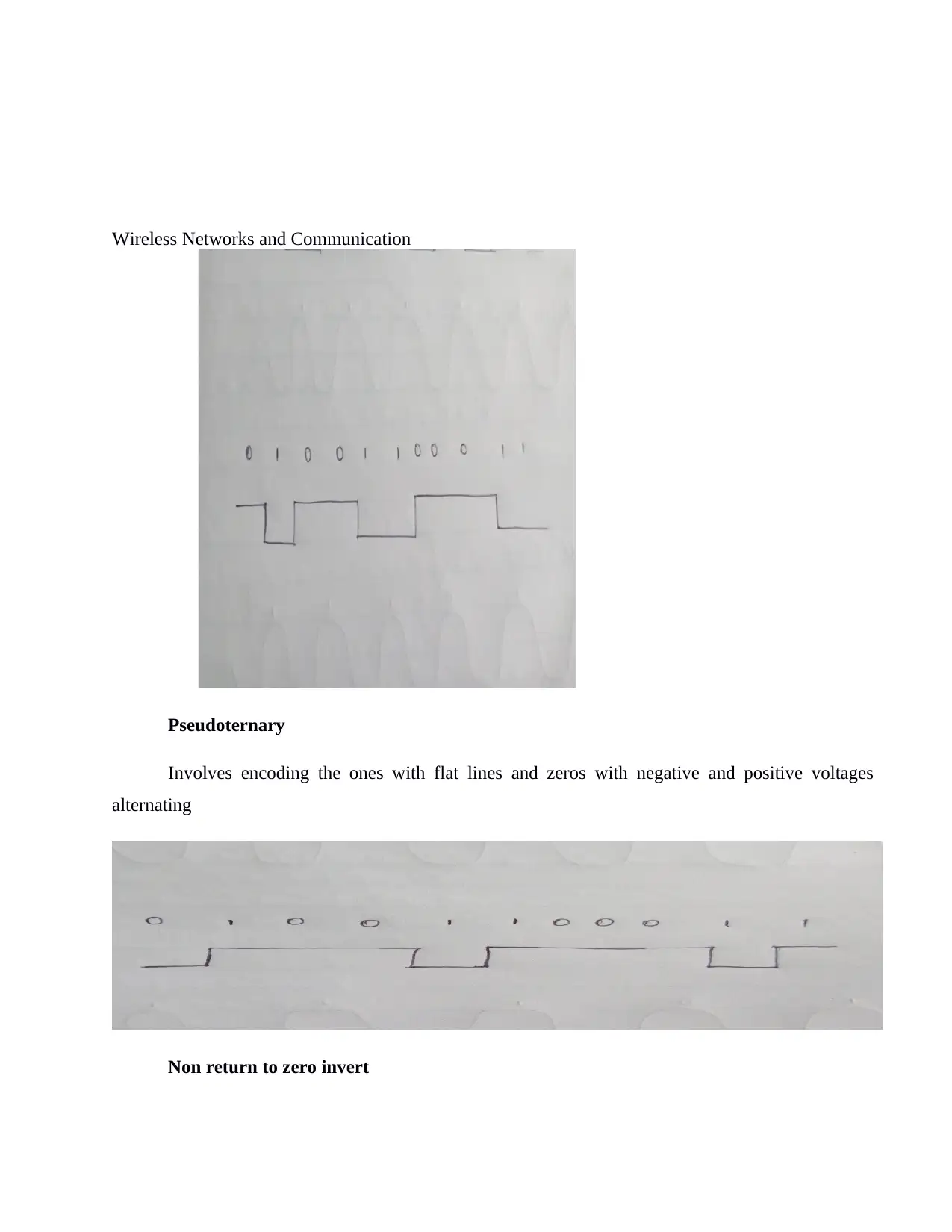
Wireless Networks and Communication
Pseudoternary
Involves encoding the ones with flat lines and zeros with negative and positive voltages
alternating
Non return to zero invert
Pseudoternary
Involves encoding the ones with flat lines and zeros with negative and positive voltages
alternating
Non return to zero invert
⊘ This is a preview!⊘
Do you want full access?
Subscribe today to unlock all pages.

Trusted by 1+ million students worldwide
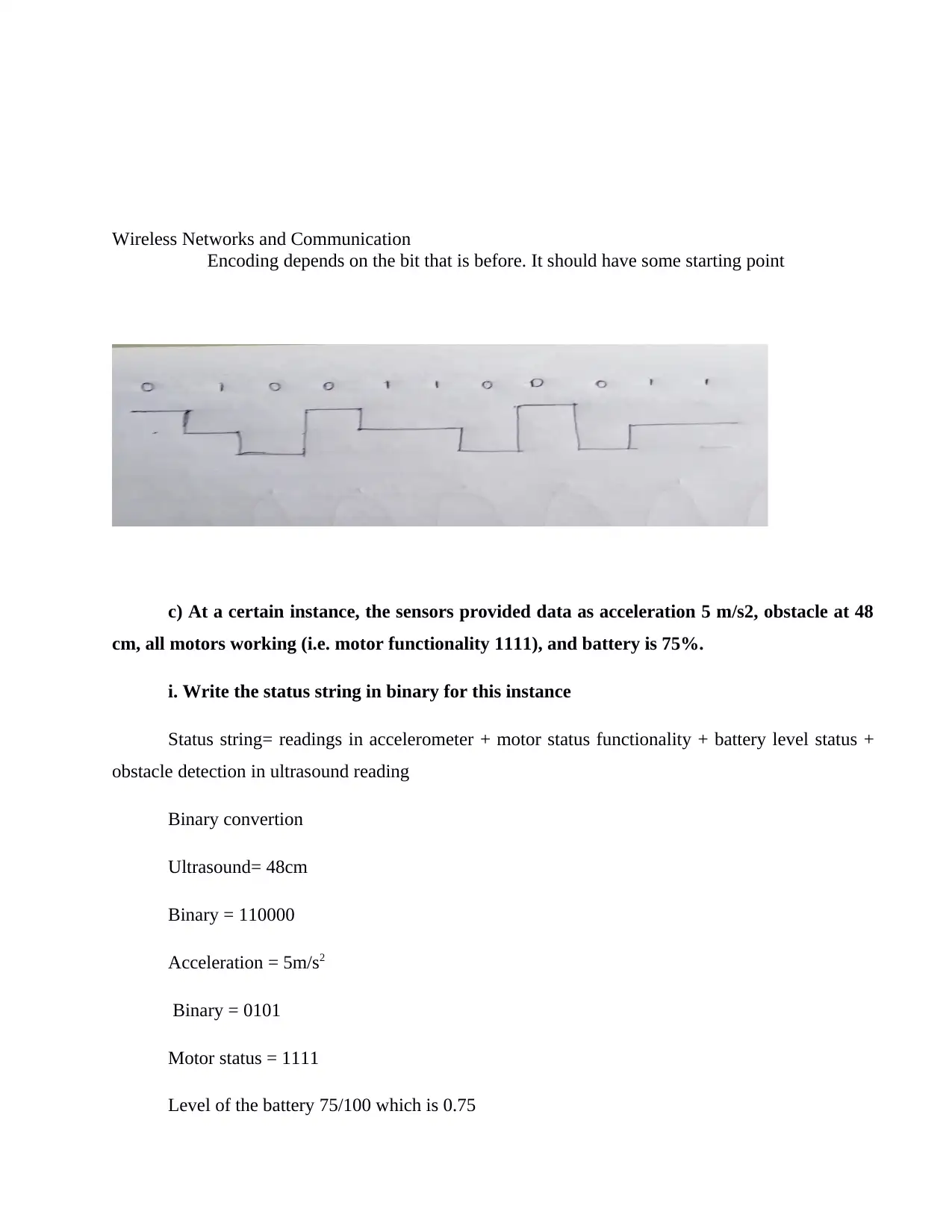
Wireless Networks and Communication
Encoding depends on the bit that is before. It should have some starting point
c) At a certain instance, the sensors provided data as acceleration 5 m/s2, obstacle at 48
cm, all motors working (i.e. motor functionality 1111), and battery is 75%.
i. Write the status string in binary for this instance
Status string= readings in accelerometer + motor status functionality + battery level status +
obstacle detection in ultrasound reading
Binary convertion
Ultrasound= 48cm
Binary = 110000
Acceleration = 5m/s2
Binary = 0101
Motor status = 1111
Level of the battery 75/100 which is 0.75
Encoding depends on the bit that is before. It should have some starting point
c) At a certain instance, the sensors provided data as acceleration 5 m/s2, obstacle at 48
cm, all motors working (i.e. motor functionality 1111), and battery is 75%.
i. Write the status string in binary for this instance
Status string= readings in accelerometer + motor status functionality + battery level status +
obstacle detection in ultrasound reading
Binary convertion
Ultrasound= 48cm
Binary = 110000
Acceleration = 5m/s2
Binary = 0101
Motor status = 1111
Level of the battery 75/100 which is 0.75
Paraphrase This Document
Need a fresh take? Get an instant paraphrase of this document with our AI Paraphraser
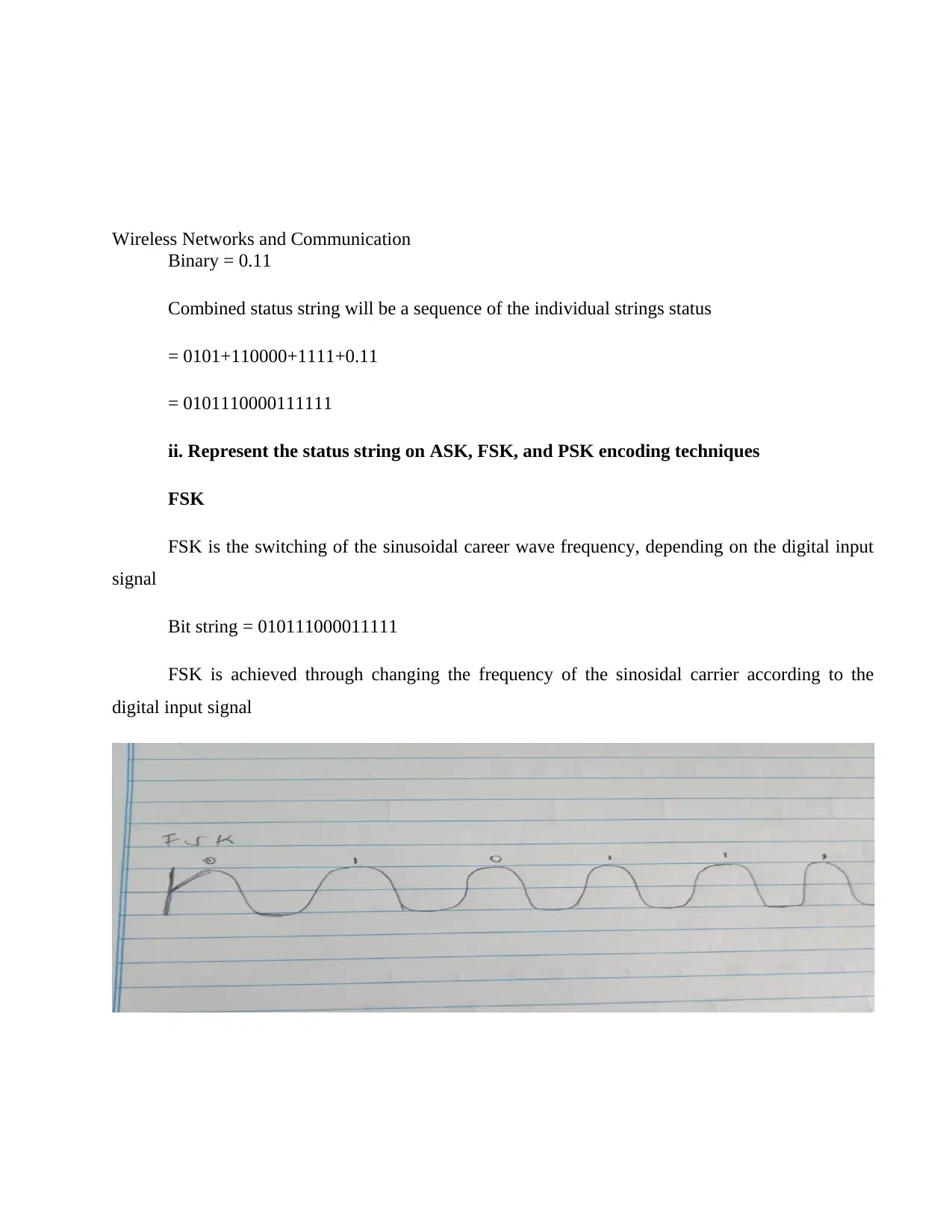
Wireless Networks and Communication
Binary = 0.11
Combined status string will be a sequence of the individual strings status
= 0101+110000+1111+0.11
= 0101110000111111
ii. Represent the status string on ASK, FSK, and PSK encoding techniques
FSK
FSK is the switching of the sinusoidal career wave frequency, depending on the digital input
signal
Bit string = 010111000011111
FSK is achieved through changing the frequency of the sinosidal carrier according to the
digital input signal
Binary = 0.11
Combined status string will be a sequence of the individual strings status
= 0101+110000+1111+0.11
= 0101110000111111
ii. Represent the status string on ASK, FSK, and PSK encoding techniques
FSK
FSK is the switching of the sinusoidal career wave frequency, depending on the digital input
signal
Bit string = 010111000011111
FSK is achieved through changing the frequency of the sinosidal carrier according to the
digital input signal
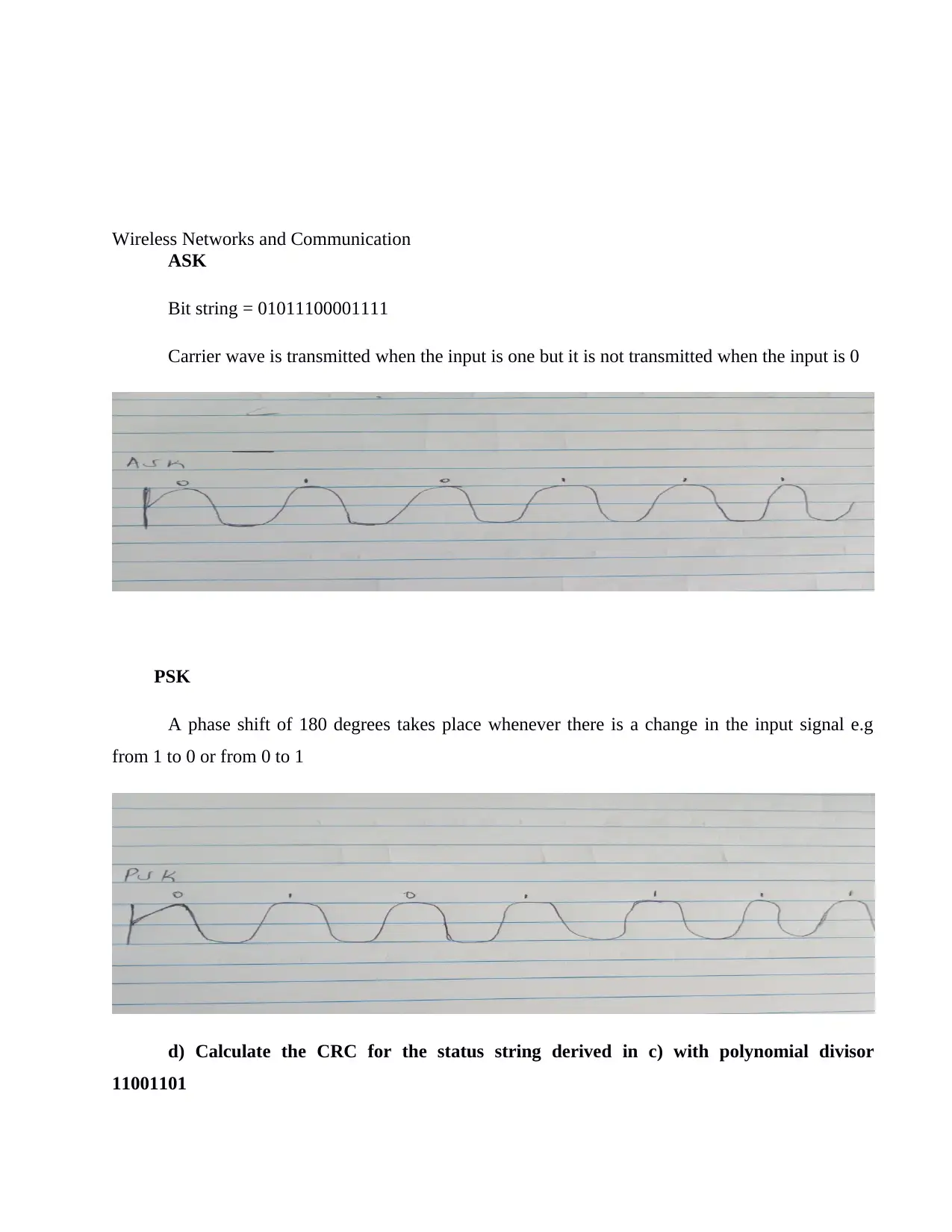
Wireless Networks and Communication
ASK
Bit string = 01011100001111
Carrier wave is transmitted when the input is one but it is not transmitted when the input is 0
PSK
A phase shift of 180 degrees takes place whenever there is a change in the input signal e.g
from 1 to 0 or from 0 to 1
d) Calculate the CRC for the status string derived in c) with polynomial divisor
11001101
ASK
Bit string = 01011100001111
Carrier wave is transmitted when the input is one but it is not transmitted when the input is 0
PSK
A phase shift of 180 degrees takes place whenever there is a change in the input signal e.g
from 1 to 0 or from 0 to 1
d) Calculate the CRC for the status string derived in c) with polynomial divisor
11001101
⊘ This is a preview!⊘
Do you want full access?
Subscribe today to unlock all pages.

Trusted by 1+ million students worldwide
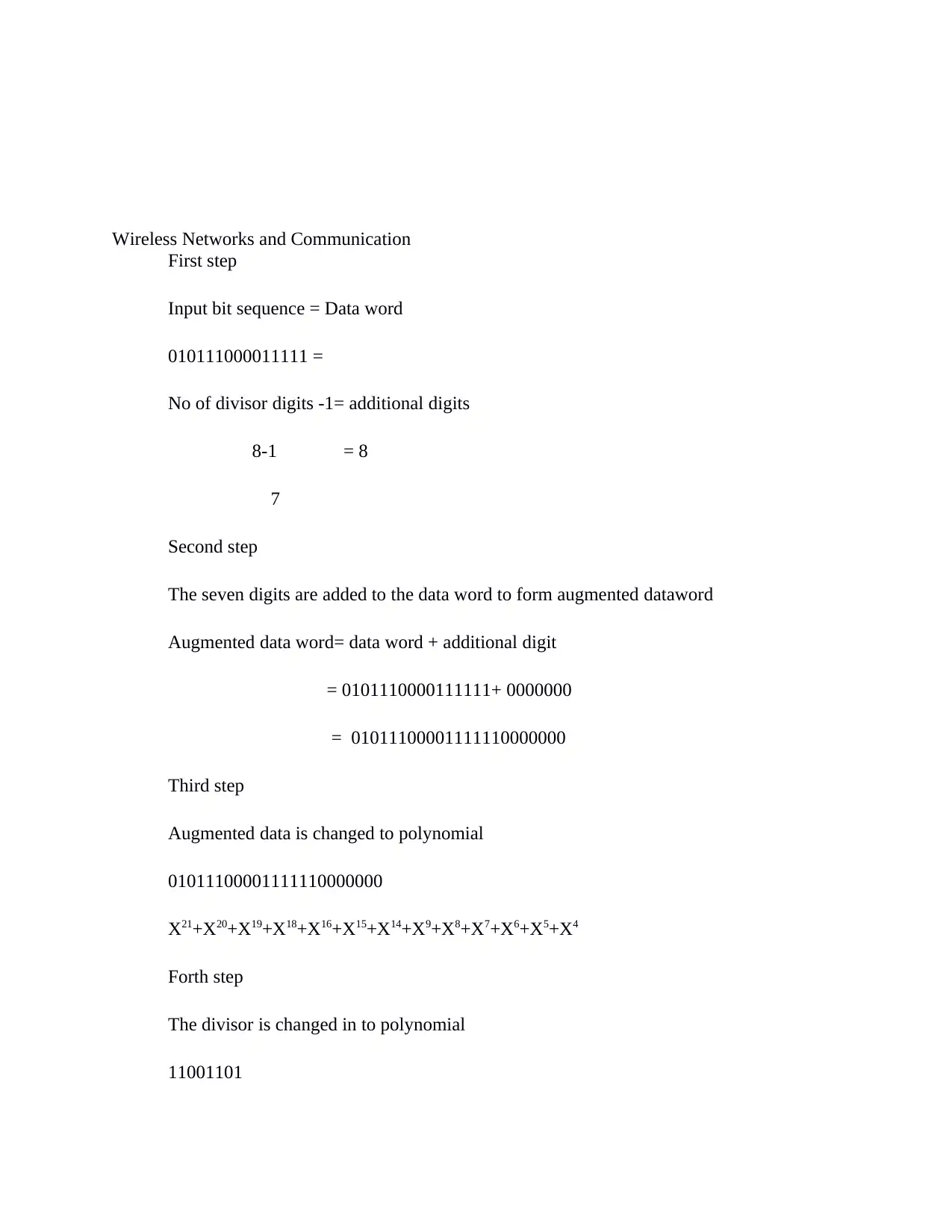
Wireless Networks and Communication
First step
Input bit sequence = Data word
010111000011111 =
No of divisor digits -1= additional digits
8-1 = 8
7
Second step
The seven digits are added to the data word to form augmented dataword
Augmented data word= data word + additional digit
= 0101110000111111+ 0000000
= 01011100001111110000000
Third step
Augmented data is changed to polynomial
01011100001111110000000
X21+X20+X19+X18+X16+X15+X14+X9+X8+X7+X6+X5+X4
Forth step
The divisor is changed in to polynomial
11001101
First step
Input bit sequence = Data word
010111000011111 =
No of divisor digits -1= additional digits
8-1 = 8
7
Second step
The seven digits are added to the data word to form augmented dataword
Augmented data word= data word + additional digit
= 0101110000111111+ 0000000
= 01011100001111110000000
Third step
Augmented data is changed to polynomial
01011100001111110000000
X21+X20+X19+X18+X16+X15+X14+X9+X8+X7+X6+X5+X4
Forth step
The divisor is changed in to polynomial
11001101
Paraphrase This Document
Need a fresh take? Get an instant paraphrase of this document with our AI Paraphraser
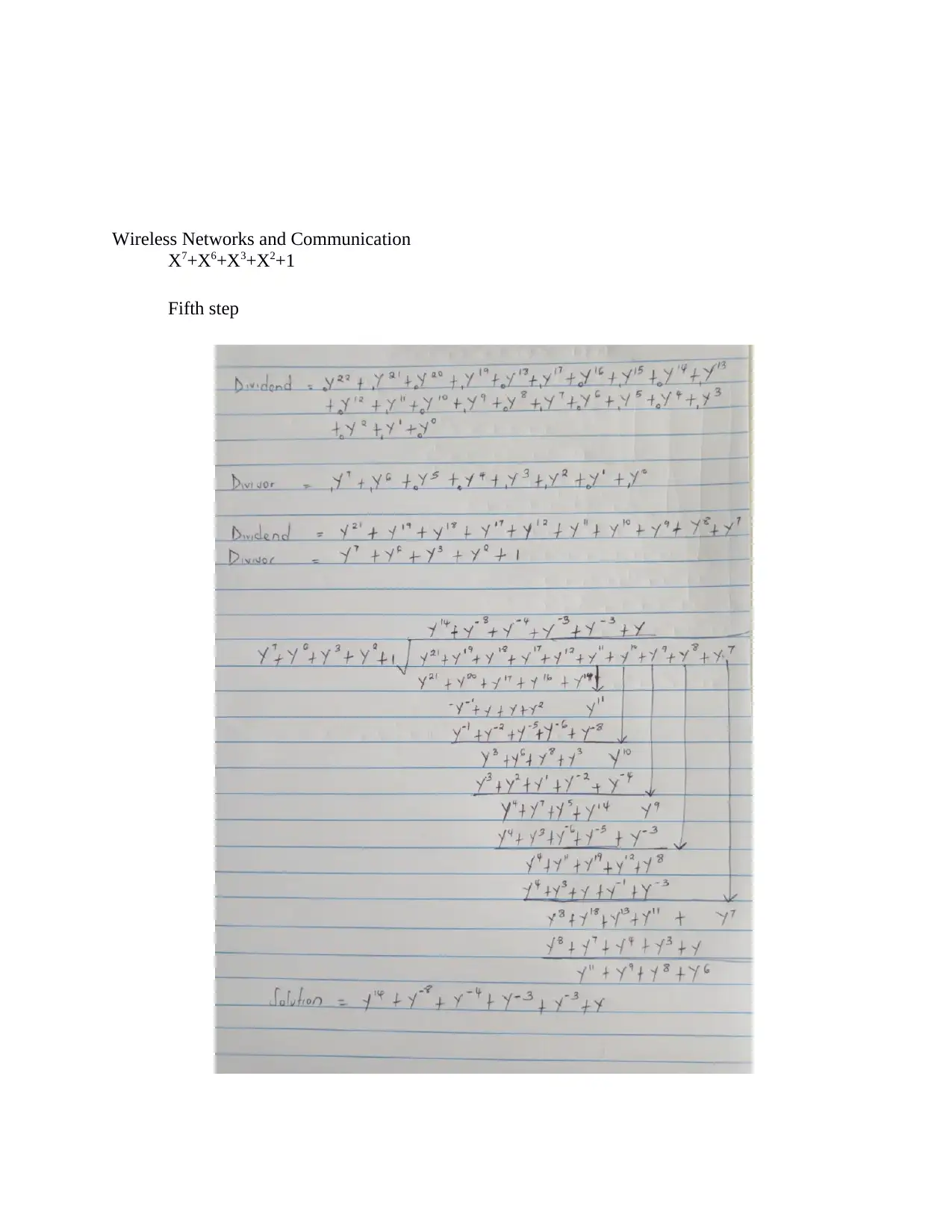
Wireless Networks and Communication
X7+X6+X3+X2+1
Fifth step
X7+X6+X3+X2+1
Fifth step
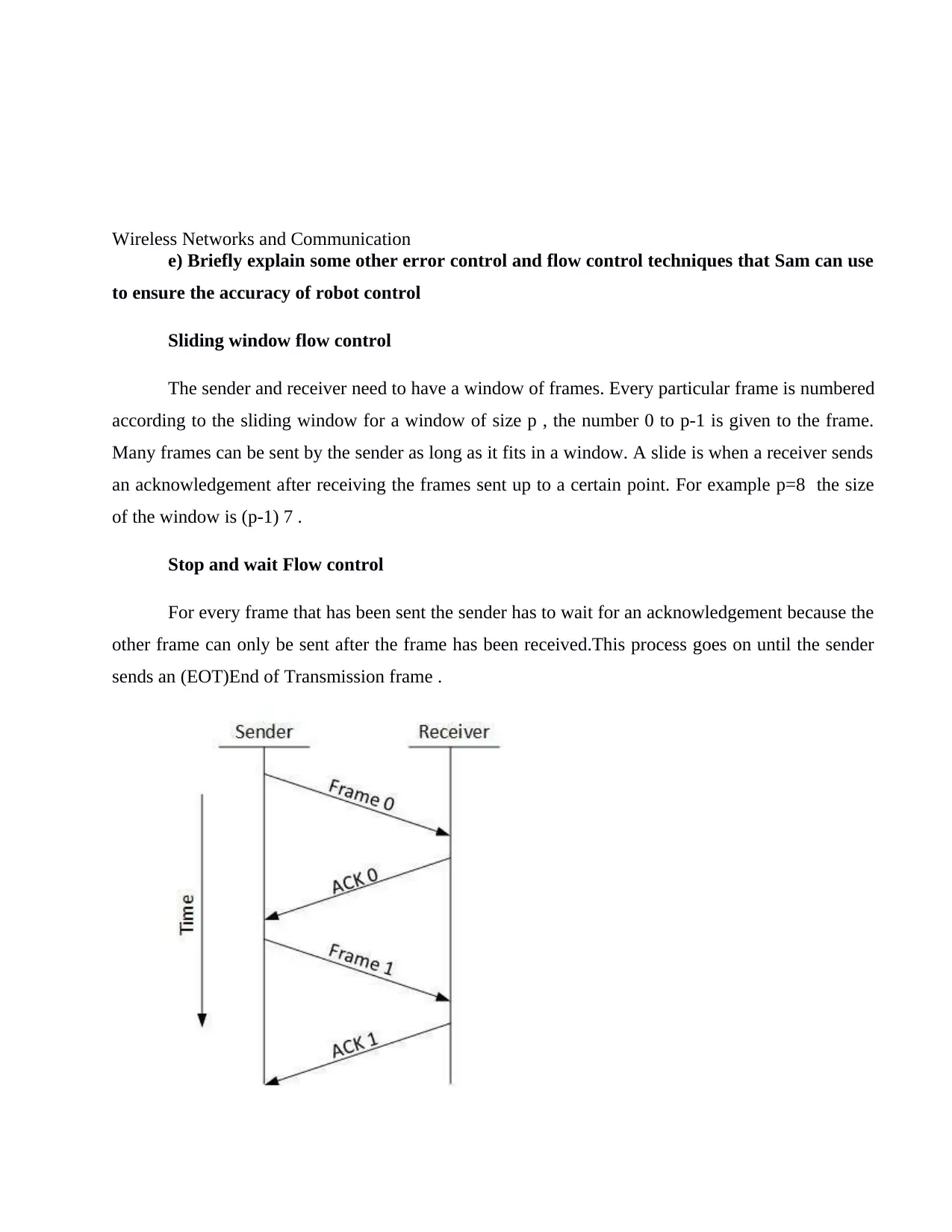
Wireless Networks and Communication
e) Briefly explain some other error control and flow control techniques that Sam can use
to ensure the accuracy of robot control
Sliding window flow control
The sender and receiver need to have a window of frames. Every particular frame is numbered
according to the sliding window for a window of size p , the number 0 to p-1 is given to the frame.
Many frames can be sent by the sender as long as it fits in a window. A slide is when a receiver sends
an acknowledgement after receiving the frames sent up to a certain point. For example p=8 the size
of the window is (p-1) 7 .
Stop and wait Flow control
For every frame that has been sent the sender has to wait for an acknowledgement because the
other frame can only be sent after the frame has been received.This process goes on until the sender
sends an (EOT)End of Transmission frame .
e) Briefly explain some other error control and flow control techniques that Sam can use
to ensure the accuracy of robot control
Sliding window flow control
The sender and receiver need to have a window of frames. Every particular frame is numbered
according to the sliding window for a window of size p , the number 0 to p-1 is given to the frame.
Many frames can be sent by the sender as long as it fits in a window. A slide is when a receiver sends
an acknowledgement after receiving the frames sent up to a certain point. For example p=8 the size
of the window is (p-1) 7 .
Stop and wait Flow control
For every frame that has been sent the sender has to wait for an acknowledgement because the
other frame can only be sent after the frame has been received.This process goes on until the sender
sends an (EOT)End of Transmission frame .
⊘ This is a preview!⊘
Do you want full access?
Subscribe today to unlock all pages.

Trusted by 1+ million students worldwide
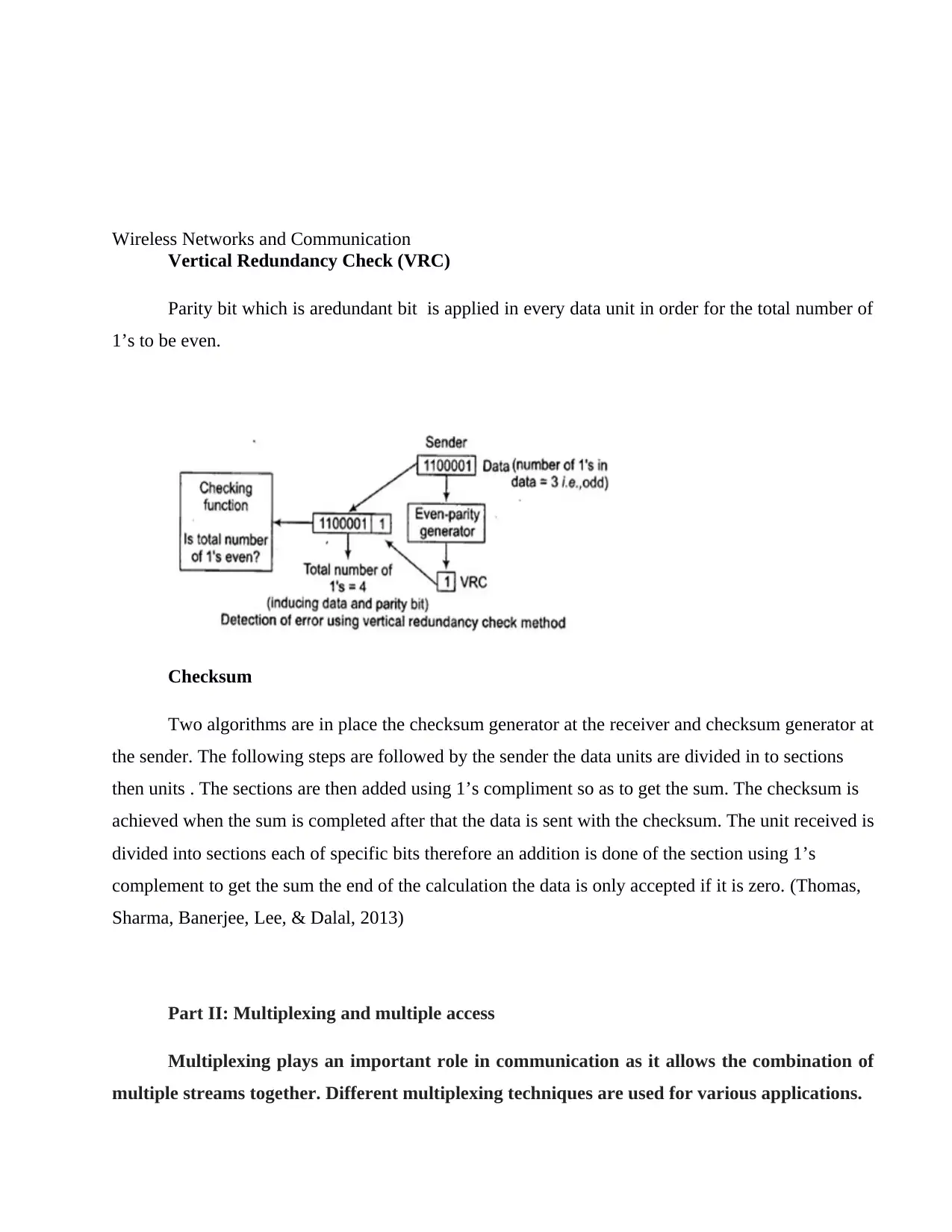
Wireless Networks and Communication
Vertical Redundancy Check (VRC)
Parity bit which is aredundant bit is applied in every data unit in order for the total number of
1’s to be even.
Checksum
Two algorithms are in place the checksum generator at the receiver and checksum generator at
the sender. The following steps are followed by the sender the data units are divided in to sections
then units . The sections are then added using 1’s compliment so as to get the sum. The checksum is
achieved when the sum is completed after that the data is sent with the checksum. The unit received is
divided into sections each of specific bits therefore an addition is done of the section using 1’s
complement to get the sum the end of the calculation the data is only accepted if it is zero. (Thomas,
Sharma, Banerjee, Lee, & Dalal, 2013)
Part II: Multiplexing and multiple access
Multiplexing plays an important role in communication as it allows the combination of
multiple streams together. Different multiplexing techniques are used for various applications.
Vertical Redundancy Check (VRC)
Parity bit which is aredundant bit is applied in every data unit in order for the total number of
1’s to be even.
Checksum
Two algorithms are in place the checksum generator at the receiver and checksum generator at
the sender. The following steps are followed by the sender the data units are divided in to sections
then units . The sections are then added using 1’s compliment so as to get the sum. The checksum is
achieved when the sum is completed after that the data is sent with the checksum. The unit received is
divided into sections each of specific bits therefore an addition is done of the section using 1’s
complement to get the sum the end of the calculation the data is only accepted if it is zero. (Thomas,
Sharma, Banerjee, Lee, & Dalal, 2013)
Part II: Multiplexing and multiple access
Multiplexing plays an important role in communication as it allows the combination of
multiple streams together. Different multiplexing techniques are used for various applications.
Paraphrase This Document
Need a fresh take? Get an instant paraphrase of this document with our AI Paraphraser
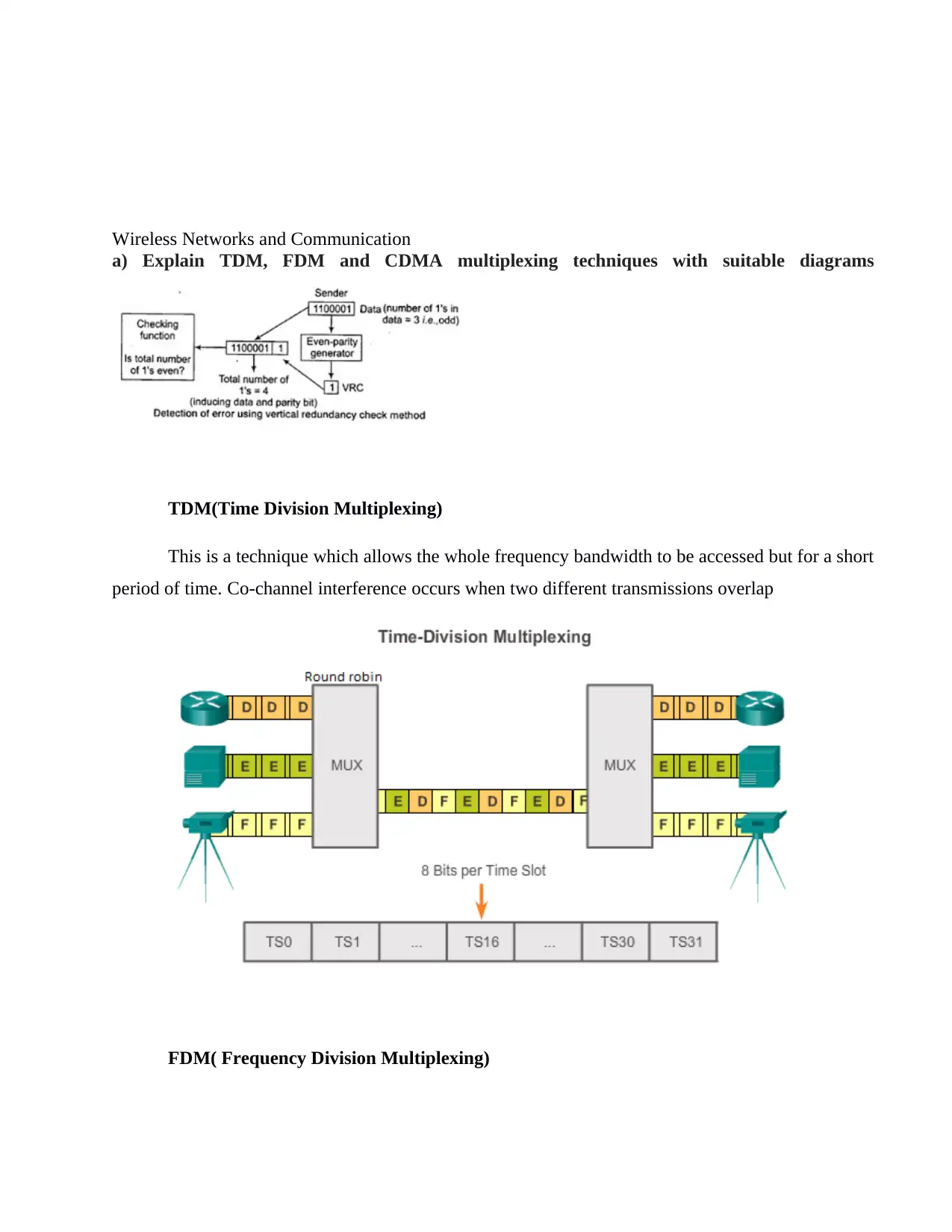
Wireless Networks and Communication
a) Explain TDM, FDM and CDMA multiplexing techniques with suitable diagrams
TDM(Time Division Multiplexing)
This is a technique which allows the whole frequency bandwidth to be accessed but for a short
period of time. Co-channel interference occurs when two different transmissions overlap
FDM( Frequency Division Multiplexing)
a) Explain TDM, FDM and CDMA multiplexing techniques with suitable diagrams
TDM(Time Division Multiplexing)
This is a technique which allows the whole frequency bandwidth to be accessed but for a short
period of time. Co-channel interference occurs when two different transmissions overlap
FDM( Frequency Division Multiplexing)
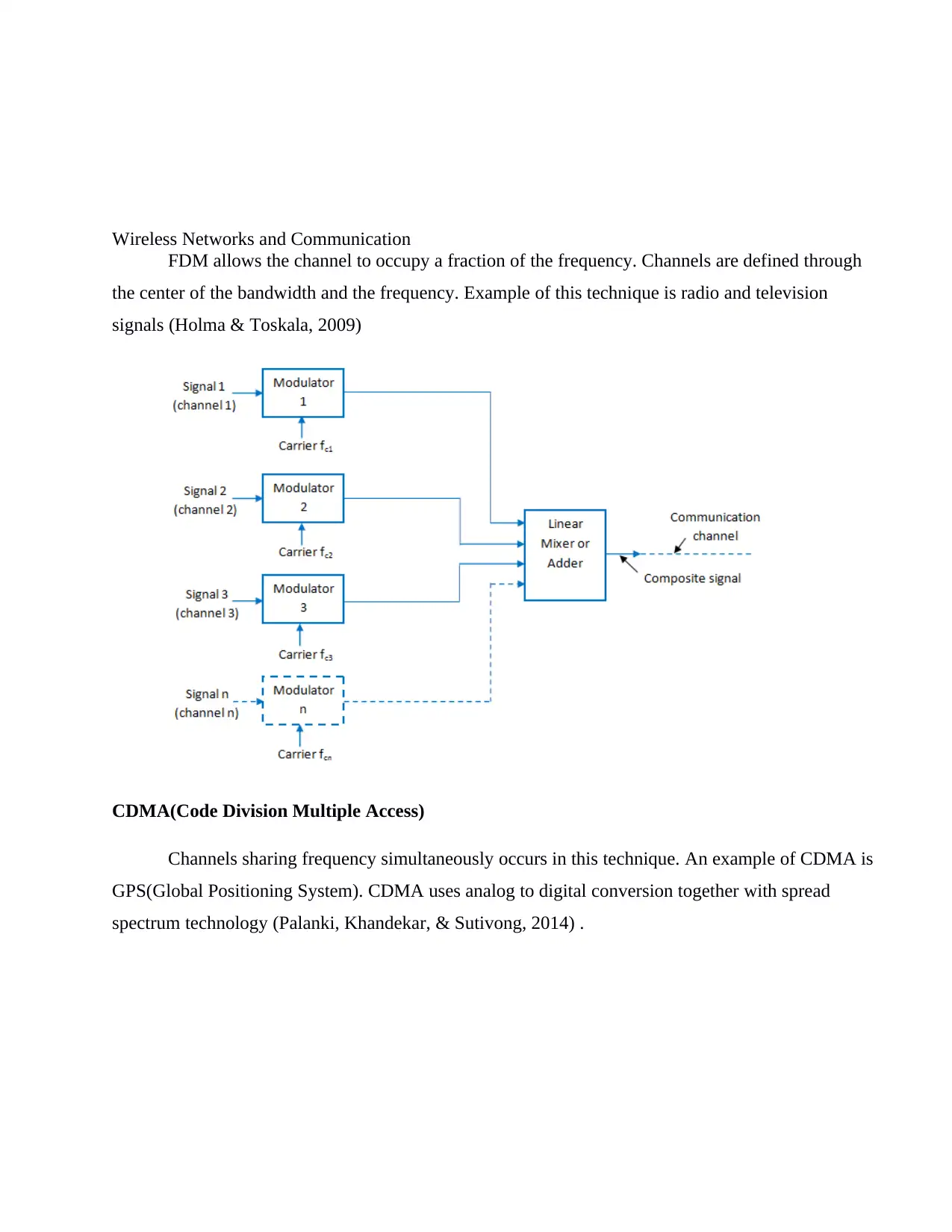
Wireless Networks and Communication
FDM allows the channel to occupy a fraction of the frequency. Channels are defined through
the center of the bandwidth and the frequency. Example of this technique is radio and television
signals (Holma & Toskala, 2009)
CDMA(Code Division Multiple Access)
Channels sharing frequency simultaneously occurs in this technique. An example of CDMA is
GPS(Global Positioning System). CDMA uses analog to digital conversion together with spread
spectrum technology (Palanki, Khandekar, & Sutivong, 2014) .
FDM allows the channel to occupy a fraction of the frequency. Channels are defined through
the center of the bandwidth and the frequency. Example of this technique is radio and television
signals (Holma & Toskala, 2009)
CDMA(Code Division Multiple Access)
Channels sharing frequency simultaneously occurs in this technique. An example of CDMA is
GPS(Global Positioning System). CDMA uses analog to digital conversion together with spread
spectrum technology (Palanki, Khandekar, & Sutivong, 2014) .
⊘ This is a preview!⊘
Do you want full access?
Subscribe today to unlock all pages.

Trusted by 1+ million students worldwide
1 out of 18
Related Documents
Your All-in-One AI-Powered Toolkit for Academic Success.
+13062052269
info@desklib.com
Available 24*7 on WhatsApp / Email
![[object Object]](/_next/static/media/star-bottom.7253800d.svg)
Unlock your academic potential
Copyright © 2020–2025 A2Z Services. All Rights Reserved. Developed and managed by ZUCOL.



